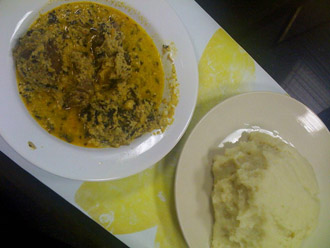Selection and storage
Yams can be available in the markets year-round. Fresh tubers, however, are available in plenty by August when their annual harvest season begins, marking the end of the rainy season in Western Africa. A new yam festival is celebrated with great fervor as a symbol of fresh crops and the availability of fresh food in abundance all over Nigeria and Ghana.
In the supermarkets, generally one can come across, small cut sections of yam wrapped in thin plastic films. Their interior meat is white to light pink depending upon the cultivar type with a rich, starchy flavor.
In general, whole tubers are stored after drying for several hours under the sunlight, in well-ventilated yam barns (traditional storage system) where they stay well for several months. Cut sections, however, should be used early or stored in the refrigerator for immediate use.
Preparation and serving methods
Unlike sweet potatoes which can be eaten raw, yams should never be consumed uncooked since they carry naturally-occurring plant toxins including dioscorine, diosgenin, and triterpenes. The tuber must be peeled and cooked in order to remove these bitter proteins.
Dioscorea opposita or Japanese yam, however, can be eaten raw, unlike its African brethren. Here, the whole root is briefly soaked in the vinegar-water solution to neutralize irritant oxalate crystals found in their skin. The root is then cut into small slices or grated to get gel-like milk to add to mouth-watering East-Asian recipes.
Here are some serving tips:
 |
| Pounded yam recipe, fufu. Photo: Saabir |
-
The tuber can be used in a variety of cuisines boiled, baked, fried, or sometimes roasted.
-
The most common cooking method in Africa is “pounded yam.” Fufu (Foo-foo, Foufou) is a special dish prepared during the yam festival. To make fufu; either pounded yam or its powder is added to boiling water to make a round cake-like dough (clump). A bite-sized piece of the fufu is then consumed with sauce, stew, or soup akin to ragi cake (finger-millet, Eleusine coracana, ragi-mudde) eaten in some parts of South India.
-
Japanese yam or yamaimo is eaten raw in salads or grated to get gel-like milk, which is then added to noodles.
-
It also used much like sweet potatoes in the preparation of cake, casseroles, bread, etc.
Medicinal uses
Yam tubers used various traditional medicines in China, Korea, and Japan. Its mucilaginous tuber milk contains allantoin, a cell proliferation that speeds up the healing process when applied to ulcers, boils, and abscesses. Its decoction is also used to stimulate appetite and to relieve bronchial irritation, cough, etc. (Medical disclaimer).
Safety profile
Yams of African species must be cooked before safely eaten because various natural toxic substances such as dioscorine can cause illness if
consumed raw.(Medical disclaimer).
≺≺ Read Sweet potatoes nutrition facts and health benefits.
≺≺ Back to Vegetables from Yams. Visit here for an impressive list of vegetables with complete illustrations of their nutrition facts and
health benefits.
≺≺ Back to Home page.
Further reading:
USDA – Nutrient Database for Standard Reference.

